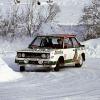2. As a rule of thumb you turn the spinner in the direction of wheel rotation to remove them.
3. Rudge Whitworth hub nuts have a FEMALE taper, and its the eplicyclic (ish) movement between wheel and hub /nut which tightens the nut as the car drives forward. Hub nut inertia effect during acceleration and braking is in my opinion a red-herring on this matter.
Hopefully everyone agrees with 1. and 2. I think 3. is also true, and it bears out by the fact that Lotus Elans undo in the opposite direction. Elans have a MALE taper on the nut, so it seems logical to me that as the taper direction is reversed, so is the thread direction.
Why then do racing Cobras with Halibrand wheels, tri-spinners with MALE tapers on the nuts have thread directions as per the Rudge Whitworth design.
Is it any coincidence that we saw/see racing Cobras with lockwire on their tri-spinners?
Please forgive me if this has been covered elsewhere/before.
Many thanks,
JB
Edited by JBaxter, 24 August 2012 - 21:14.


















